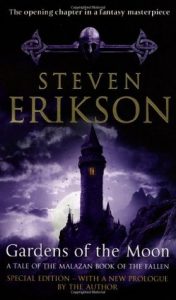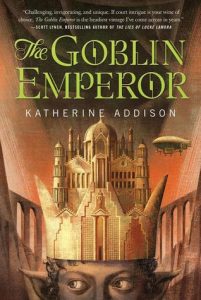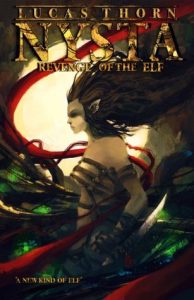Tough Travelling: Elves
Welcome to Tough Travelling, a monthly feature in which we rack our brains for popular (and not so popular) examples of fantasy tropes.
Created by Nathan of Fantasy Review Barn, revived on Fantasy Faction and now continued by the team here at the Hive, Tough Travelling is inspired by the informative and hilarious Tough Guide to Fantasyland by Diana Wynne Jones. Fellow bloggers are absolutely welcome to join in – just make your own list, publish it on your site, and then submit the link at the end of this article!

This month, we’re searching for ELVES. Before we begin, let’s see what the Tough Guide has to say about them:
“Elves claim to have been the first people in Fantasyland. They are called the Elder Race. They did not, they claim, evolve like humans, but sprang into being just as they are now.
“The Elves’ claim is borne out to some extent by the well attested fact that their flesh is less gross and substantial than that of humans.
“In looks, Elves are taller and more slender than any humans, and very beautiful. Most of them appear youthful.
“All Elves feel themselves superior to humans and make it very clear that they do not operate by human rules. This is true, in that many of them can do some MAGIC.
“If you meet Elves, expect to have to listen for hours while they tell you how great numbers of their race have become so wearied with the thinning of the old golden wonders that they have all departed, departed into the West. This is correct; many Elves have indeed gone West, to Minnesota and thence to California, where they have great fun wearing punk clothes and riding motorbikes.”
– The Tough Guide to Fantasyland by Diana Wynne Jones
OUR PICKS:

LEGOLAS, GALADRIEL, CELEBORN, ETC.
(The Lord of the Rings by J. R. R. Tolkien)
You didn’t think we’d have a list of elves and NOT mention Tolkien, did you?
Tall, fair, pointy-eared: Tolkien pretty much wrote the manual on elves, and the elves in his stories created the mold for much of what has come afterwards.
Immortal? Check. Forest-dwelling? Check. Improbably skilled with a bow? Check. Racial enmity with the dwarves? Check.
 THE ELVES
THE ELVES
(The Riftwar Cycle by Raymond E. Feist)
Feist’s elves are very similar to Tolkien’s. Long-lived, magical, perfect in every way – they even live in forests. Though not quite as hostile as many other elves, Feist’s elder race are still pretty standoffish, and on the whole do not tend to concern themselves much with the affairs of mere mortals like Pug and Thomas in Magician.
However, in the Serpentwar Saga, one fairly awesome half-elf, Calis, takes a much more active role in the defence of Midkemia. Calis leads a rag-tag band of soldiers and outlaws under the banner of a false mercenary company in order to infiltrate an enemy army, which I suppose is a little different from Tolkien’s elves (i.e. sitting around looking disapproving).
 HOUSE ELVES
HOUSE ELVES
(Harry Potter by J. K. Rowling)
The elves in Harry Potter are not tall, graceful and elegant. In fact, they are tiny, wizened creatures, whose sole purpose is to act as servants to the most rich and powerful wizarding families. They do possess magical power, but are severely restricted in its use: in fact, they are so strictly bound to servitude that they have virtually no free will of their own, and are magically compelled to punish themselves should they ever do or say anything against their master’s wishes.
The most popular example of a house elf is Dobby, of course, who spends most of The Chamber of Secrets endangering Harry while at the same time trying to save his life. But others are not so well-intentioned . . .
 THE DROW
THE DROW
(The Forgotten Realms by R. A. Salvatore)
The Drow, or Dark Elves, are very different from the surface elves, and crop up in most fantasy RPGs. According to the mythos of Salvatore, the Drow live in colossal underground cities and conduct dark rituals in the name of the spider goddess Lolth.
Yup, that’s right. Spiders. *shudders*
The Drow are a cruel race (with the lone exception of Salvatore’s hero, Drizzt Do’Urden). The underground society of Menzoberranzan is matriarchal, and its rulers are obsessed with conducting ruthless and bloodthirsty political schemes against one another in order to raise their family’s status in the eyes of Lolth.
 ELVES
ELVES
(The Bloodline trilogy by T. O. Munro)
The silver elves are forest-dwelling, human-hating immortal beings with no interest in anything except preserving their own little slice of paradise. Like many elves, these guys think themselves superior to most other races, and believe their lands immune to the corrupting darkness spreading across the neighbouring territories.
However, similarly to Calis in Feist’s Serpentwar Saga, some of Munro’s elves – especially the half-elves Rugen and Quintala – breathe new life into the trope, behaving in ways that are often unexpected (and occasionally infuriating).
 THE EBORANS
THE EBORANS
(The Ninth Rain by Jen Williams)
What if Tolkien’s elves began to lose their immortality? What might happen if they realised that drinking human blood could partially restore it? What if they then realised that the blood infected all who drank it with a wasting disease known as the Crimson flux – and that now their species is dying out faster than ever?
If there’s one thing Jen Williams does well (and there are many), it’s traditional tropes with a twist, and the ‘elves’ in The Ninth Rain are no exception. Recognisable yet strange, the Eborans – an unnaturally beautiful, long-lived race who keep themselves separate from mere mortals – might make readers might roll their eyes and mutter ‘elves’. But in a dark spin on the traditional, Williams takes the Tolkien-esque elves (and other wonders) and filters them through her own unique imagination. She then takes what’s left in the filter – the grit, the dirt, the uncomfortable, the bitter and the hard-to-chew – and mixes it with all kinds of unlikely ingredients with the experimental skill and competence of a chemist. Voila! The Eborans.
 ELF RATS
ELF RATS
(The White Towers by Andy Remic)
Speaking of twisting tropes – well, twisting just about everything, really – the Elf Rats are perhaps the furthest from most people’s ideas about ‘traditional’ elves than any other entries on this list.
In the grimmest, darkest of grimdark worlds, populated by vile mud orcs and inhuman splice, lurk creatures that even the most vicious, genocidal monsters would cross the street to avoid.
Sure, the Elf Rats are genocidal monsters themselves, but they’re genocidal monsters with motivations and a toxic history; as such, they’ve got it in for mankind much more aggressively than the Eborans, the silver elves, or even the Drow.
 THE TISTE ANDII
THE TISTE ANDII
(The Malazan Book of the Fallen by Steven Erikson)
You know how the elves in The Lord of the Rings are tall and majestic and distant and cold and also just a little bit depressing? Well, picture them with midnight skin and moon-white hair. Now imagine that some of them are also capable of shapeshifting into dragons, while others wield primeval magic and weapons with impossible skill. And then – just for kicks – place them all on a colossal flying mountain and name it “Moon’s Spawn”.
Are you picturing it? Good. That’s the Tiste Andii.
Their leader is Anomander Rake, who is literally the Son of Darkness. As in, his mum is Mother Dark. This makes him sort of a cross between Ozzy Osbourne and Jesus. Ageless, intelligent, and powerful beyond all measure, Rake is the brooding but badass leader of the Tiste Andii race. Move over, Galadriel!

THE DWENDA
(A Land Fit for Heroes by Richard Morgan)
A bit like the Tiste Andii, the Dwenda have got a lot of the normal elf traits – long lived, beautiful, ethereal, deadly – but with some more fae flavour thrown in – mostly do to with the moon, time dilation – and a few sci-fi elements as well.
Also, they’re terrifying.

THE TANU
(Saga of the Pliocene Exile by Julian May)
Tall . . . slim . . . beautiful . . . often with fair hair, and green or blue eyes . . . possessing latent metapsychic abilities . . . yes, the Tanu are definitely ‘elves’ as we know them.
A ‘superior’ race, the Tanu do deign to breed with humans in order to bolster their numbers. Interestingly, the Tanu can be poisoned by iron weapons, which also gives them something of a resemblance to the fae.
 ELVES
ELVES
(The Goblin Emperor by Katherine Addison)
In this beautiful gentle book of intrigue, court culture and a deeply divided society, the elves and goblins are a short hand for race. The eponymous hero, half-goblin offspring of a purely diplomatic marriage, was never intended to succeed to the throne. Inequalities of class and gender jostle for attention alongside the racial tension between the beautiful ephemeral arrogant elves and the grey skinned goblins always a subservient race beyond the boundaries of their own country. The book might have worked well with any other pairing of fictional or historic racial antipathies, but in selecting the ones she does, Katherine Addison goes straight to the heart of our knee-jerk prejudice to always believe good of the beautiful, and think ill of the ugly.
 ELVES
ELVES
(Lords and Ladies by Terry Pratchett)
Terry Pratchett mined and twisted many tropes as well as projecting the modern world in some distorted way onto the screen of fantasy writing.
In Lords and Ladies we meet elves who are as deadly and unpleasant as they are fine and beautiful. One guesses that an immortal lifespan would bring a certain arrogance towards shorter lived races – creatures regarded at best as pets, at worst as cattle.
Pratchett’s elves are parasites preying on parallel world of mortals and it seems only the headology of my favourite witch Granny Weatherwax and her coven can stand against them.

NYSTA
(Revenge of the Elf by Lucas Thorn)
Nysta, protagonist more than heroine, is a very different kind of elf. Not so much leader of a gilded host as a solitary hunter; not willowy and ethereal, more waspish and feral; not driven by beauty and idealism, but fuelled by an incoherent rage for revenge.
Above all else, Nysta is neither elegant nor eloquent in word and thought; no, with every utterance of her intemperate tongue Nysta raids the lexicon of curses and proves that she is one motherfucker of an elf.
This month’s Tough Travelling picks were brought to you by T. O. Munro, James Latimer, J. P. Ashman, Dorian Hart, Alicia Wanstall-Burke, Kareem Mahfouz and Laura M. Hughes.
[inlinkz_linkup id=757203 mode=1]
Next month we’ll be hunting for… SHAPESHIFTERS.
“Shapeshifting is frequent among both WERES and MAGIC USERS. The usual form taken is that of a wolf, but lions, eagles, serpents, owls and cats are common too. In all cases the Rule is that the Shapeshifter cannot stay too long in ANIMAL form without actually becoming that animal and losing touch with her/his human thoughts.”
– The Tough Guide to Fantasyland by Diana Wynne Jones

[…] be joining in with a couple of different features throughout the month, including reviving our Tough Travels feature; but to kick things off, some of the Hivers would like to share with you our May TBRs! If […]
Great list! I see so many series on here I’ve been intending to read but haven’t gotten to yet, not least of which is Drizzt. This is a good reminder to bump them closer to the top of my to-read list 🙂
I’m really looking forward to next month’s topic btw – shapeshifters are the best!
I really need to read more Drizzt myself! Only read the first one (Homeland), and that was many years ago. Enjoyed it a lot, though. Can’t wait to see which shapeshifters make your list, Nicola! 😀
What an amazing list – with so many elves I have not heard of before! I’m afraid my list is pretty much made up of Tolkien elves and Dobby… 😀 However I do have Terry Pratchett’s Lords and Ladies on my TBR list, so I am looking forward to meeting his take on an elf soon.
p.s. I couldn’t use the InLinkz widget above so here is the link to my post: https://thebookwormchronicles.wordpress.com/2018/01/09/tough-travels-elves/
I still have no idea why Inlinkz hates you! I added the link on your behalf. 🙂 Thanks for joining in, as always!
Can’t wait to read Lords and Ladies myself. That was one of T.O. Munro’s contributions to the list. It sounds great, plus anything Pratchett is always a win. 🙂
Thank you Laura! InLinkz really does hate me HAHA! Ooo hopefully we will both enjoy Lords and Ladies then. As you said Pratchett is always a win so we probably will 🙂
Elves are some of my favorite fantasy creatures (alongside dragons) but I haven’t read even half of your list. Great to see so many books waiting to be read! Great to see Drizzt 😉
God yes, there’s no way we could’ve left Drizzt off the list! And yes, there are a few on here that I haven’t read either. The team did themselves proud this month!
[…] Travels is a monthly meme, re-ignited by Fantasy Faction and now hosted by The Fantasy Hive, which, inspired by The Tough Guide to Fantasyland by Diana Wynne Jones, spotlights each month a […]
[…] Travelling is a monthly feature, which has a new home over at the (very swish) Fantasy Hive (hence the new […]
This list nails it. I considered an all LotR cast but I found a new elf – specially for Tough Travels.
Lynn 😀
Awesome stuff, Lynn! And YAY for representing SPFBO! 😀
Great list. A few books I’ll have to check out. But I can’t believe you left off Tad William’s Sithi from his Osten Ard series 🙂
Good thing with such interactive lists is, we didn’t miss the Sithi, thanks to you! These comment posts count 🙂 There’ll be more TBR list expansions thanks to you, Tim! 😀
Wow that’s a very comprehensive list of elves!
Team effort! Looking forward to seeing yours, Bethan. 😀
Good stuff here 🙂 but what about James Barclay and all his elves – Chronicles/Legends of the Raven had some, but his Elves series (Once Walked with Gods; Rise of the TaiGethen; and Beyond the Mists of Katura) are very good 🙂
Congrats on a lovely and (hopefully) prosperous site!!
Thanks, Carole-Ann – for the kind words, and for expanding my TBR even further. Happy New Year!! 🙂